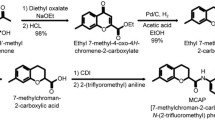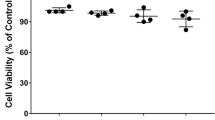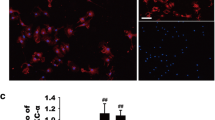Abstract
The extracellular signal-regulated kinase (ERK) is involved in the cytokine production of immune cells. In this study, we show the influence of xenon on phosphatase activity, ERK 1/2 signalling and cytokine expression in microglia. The murine microglia cell line BV-2 was treated with 50 ng/ml lipopolysaccharide (LPS) and 74% xenon in 21% O2 and 5% CO2. Cytokine levels were examined by gene expression analysis, Western blot and enzyme-linked immunosorbent assay. Phosphatase inhibition was assessed with p-nitrophenylphosphate and phosphorylation of ERK 1/2 via Western blot. Xenon significantly enhanced LPS-mediated IL-1β expression. ERK 1/2 phosphorylation was observed after xenon or LPS treatment which was inhibited by the use of the MEK inhibitor U0126. Xenon and LPS in combination superimposed individual effects on ERK 1/2 activation. Xenon decreased cellular phosphatase activity in microglia by 20% and inhibited dephosphorylation of ERK 1/2 up to 1 h. The blocking of ERK 1/2 reduced IL-1β expression in xenon and LPS-treated cells to a level obtained by LPS alone. In conclusion, xenon enhanced LPS-induced IL-1β expression in microglia by activation of ERK 1/2 signalling. Xenon’s interference with phosphatases may be a key feature to affect multiple intracellular signalling pathways.





Similar content being viewed by others
References
Amantea D, Nappi G, Bernardi G, Bagetta G, Corasaniti MT (2009) Post-ischemic brain damage: pathophysiology and role of inflammatory mediators. FEBS J 276:13–26
Barton GM, Medzhitov R (2003) Toll-like receptor signaling pathways. Science 300:1524–1525
Blasi E, Barluzzi R, Bocchini V, Mazzolla R, Bistoni F (1990) Immortalization of murine microglial cells by a v-raf/v-myc carrying retrovirus. J Neuroimmunol 27:229–237
Bocchini V, Mazzolla R, Barluzzi R, Blasi E, Sick P, Kettenmann H (1992) An immortalized cell line expresses properties of activated microglial cells. J Neurosci Res 31:616–621
Chan WY, Kohsaka S, Rezaie P (2007) The origin and cell lineage of microglia: new concepts. Brain Res Rev 53:344–354
Bye N, Habgood MD, Callaway JK et al (2007) Transient neuroprotection by minocycline following traumatic brain injury is associated with attenuated microglial activation but no changes in cell apoptosis or neutrophil infiltration. Exp Neurol 204:220–233
Clark JA, Ma D, Homi HM, Maze M, Grocott HP (2005) Xenon and the inflammatory response to cardiopulmonary bypass in the rat. J Cardiothorac Vasc Anesth 19:488–493
Coburn M, Kunitz O, Baumert JH et al (2005) Randomized controlled trial of the haemodynamic and recovery effects of xenon or propofol anaesthesia. Br J Anaesth 94:198–202
Coburn M, Maze M, Franks NP (2008) The neuroprotective effects of xenon and helium in an in vitro model of traumatic brain injury. Crit Care Med 36:588–595
Cooper ZA, Ghosh A, Gupta A et al (2010) Febrile-range temperature modifies cytokine gene expression in LPS-stimulated macrophages by differentially modifying NF-{kappa}B recruitment to cytokine gene promoters. Am J Physiol Cell Physiol 298:C171–C181
De Rossi LW, Brueckmann M, Rex S, Barderschneider M, Buhre W, Rossaint R (2004) Xenon and isoflurane differentially modulate lipopolysaccharide-induced activation of the nuclear transcription factor KB and production of tumor necrosis factor-alpha and interleukin-6 in monocytes. Anesth Analg 98:1007–1012
Feng Y, Bhatt AJ, Fratkin JD, Rhodes PG (2008) Neuroprotective effects of sodium orthovanadate after hypoxic–ischemic brain injury in neonatal rats. Brain Res Bull 76:102–108
Gabbita SP, Robinson KA, Stewart CA, Floyd RA, Hensley K (2000) Redox regulatory mechanisms of cellular signal transduction. Arch Biochem Biophys 376:1–13
Gehrmann J, Matsumoto Y, Kreutzberg GW (1995) Microglia: intrinsic immuneffector cell of the brain. Brain Res Brain Res Rev 20:269–287
Gerling N, Culmsee C, Klumpp S, Krieglstein J (2004) The tyrosine phosphatase inhibitor orthovanadate mimics NGF-induced neuroprotective signaling in rat hippocampal neurons. Neurochem Int 44:505–520
Gordon A (1991) Use of vanadate as protein-phosphotyrosine phosphatase inhibitor. Methods Enzymol 201:477–482
Guha M, Mackman N (2001) LPS induction of gene expression in human monocytes. Cell Signal 13:85–94
Haase H, Maret W (2003) Intracellular zinc fluctuations modulate protein tyrosine phosphatase activity in insulin/insulin-like growth factor-1 signaling. Exp Cell Res 291:289–298
Hasegawa Y, Hamada J, Morioka M et al (2003) Neuroprotective effect of postischemic administration of sodium orthovanadate in rats with transient middle cerebral artery occlusion. J Cereb Blood Flow Metab 23:1040–1051
Jin R, Yang G, Li G (2010) Inflammatory mechanisms in ischemic stroke: role of inflammatory cells. J Leukoc Biol 87:779–789
Jung WK, Lee DY, Park C et al (2010) Cilostazol is anti-inflammatory in BV2 microglial cells by inactivating nuclear factor-kappaB and inhibiting mitogen-activated protein kinases. Br J Pharmacol 159:1274–1285
Koshinaga M, Katayama Y, Fukushima M, Oshima H, Suma T, Takahata T (2000) Rapid and widespread microglial activation induced by traumatic brain injury in rat brain slices. J Neurotrauma 17:185–192
Kriz J (2006) Inflammation in ischemic brain injury: timing is important. Crit Rev Neurobiol 18:145–157
Laemmli UK (1970) Cleavage of structural proteins during the assembly of the head of bacteriophage T4. Nature 227:680–685
Lang R, Hammer M, Mages J (2006) DUSP meet immunology: dual specificity MAPK phosphatases in control of the inflammatory response. J Immunol 177:7497–7504
Lee K, Esselman WJ (2002) Inhibition of PTPs by H(2)O(2) regulates the activation of distinct MAPK pathways. Free Radic Biol Med 33:1121–1132
Liu JL, Tian DS, Li ZW et al (2010) Tamoxifen alleviates irradiation-induced brain injury by attenuating microglial inflammatory response in vitro and in vivo. Brain Res 1316:101–111
Loetscher PD, Rossaint J, Rossaint R et al (2009) Argon: neuroprotection in in vitro models of cerebral ischemia and traumatic brain injury. Crit Care 13:R206
Lombardo E, Alvarez-Barrientos A, Maroto B, Boscá L, Knaus UG (2007) TLR4-mediated survival of macrophages is MyD88 dependent and requires TNF-alpha autocrine signalling. J Immunol 178:3731–3739
Ma D, Lim T, Xu J et al (2009) Xenon preconditioning protects against renal ischemic-reperfusion injury via HIF-1alpha activation. J Am Soc Nephrol 20:713–720
Mio Y, Shim YH, Richards E, Bosnjak ZJ, Pagel PS, Bienengraeber M (2009) Xenon preconditioning: the role of prosurvival signaling, mitochondrial permeability transition and bioenergetics in rats. Anesth Analg 108:858–866
Morganti-Kossmann MC, Rancan M, Stahel PF, Kossmann T (2002) Inflammatory response in acute traumatic brain injury: a double-edged sword. Curr Opin Crit Care 8:101–105
O'Shea JJ, McVicar DW, Bailey TL, Burns C, Smyth MJ (1992) Activation of human peripheral blood T lymphocytes by pharmacological induction of protein-tyrosine phosphorylation. Proc Natl Acad Sci USA 89:10306–10310
Qian L, Wei SJ, Zhang D et al (2008) Potent anti-inflammatory and neuroprotective effects of TGF-beta1 are mediated through the inhibition of ERK and p47phox-Ser345 phosphorylation and translocation in microglia. J Immunol 181:660–668
Rossaint R, Reyle-Hahn M, Schulte Am Esch J, Xenon Study Group (2003) Multicenter randomized comparison of the efficacy and safety of xenon and isoflurane in patients undergoing elective surgery. Anesthesiology 98:6–13
Rousseau S, Papoutsopoulou M, Symons A et al (2008) TPL2-mediated activation of ERK1 and ERK2 regulates the processing of pre-TNF α in LPS-stimulated macrophages. J Cell Sci 121:149–154
Saravanan P, Exley AR, Valchanov K, Casey ND, Falter F (2009) Impact of xenon anaesthesia in isolated cardiopulmonary bypass on very early leucocyte and platelet activation and clearance: a randomized, controlled study. Br J Anaesth 103:805–810
Scherle PA, Jones EA, Favata MF et al (1998) Inhibition of MAP kinase kinase prevents cytokine and prostaglandin E2 production in lipopolysaccharide-stimulated monocytes. J Immunol 161:5681–5686
Subramaniam S, Unsicker K (2010) ERK and cell death: ERK 1/2 in neuronal death. FEBS J 227:22–29
Terrando N, Rei Fidalgo A, Vizcaychipi M et al (2010) The impact of IL-1 modulation on the development of lipopolysaccharide-induced cognitive dysfunction. Crit Care 14:R88
Torres M, Forman HJ (2002) Vanadate inhibition of protein tyrosine phosphatases mimics hydrogen peroxide in the activation of the ERK pathway in alveolar macrophages. Ann NY Acad Sci 973:345–348
Weber NC, Toma O, Wolter JI et al (2005) The noble gas xenon induces pharmacological preconditioning in the rat heart in vivo via induction of PKC-epsilon and p38 MAPK. Br J Pharmacol 144:123–132
Weber NC, Stursberg J, Wi.rthle NM, Toma O, Schlack W, Preckel B (2006a) Xenon preconditioning differently regulates p44/42 MAPK (ERK 1/2) and p46/54 MAPK (JNK 1/2 and 3) in vivo. Br J Anaesth 97:298–306
Weber NC, Toma O, Damla H, Wolter JI, Schlack W, Preckel B (2006b) Upstream signaling of protein kinase C-epsilon in xenon-induced pharmacological preconditioning. Implication of mitochondrial adenosine triphosphate dependent potassium channels and phosphatidylinositol-dependent kinase-1. Eur J Pharmacol 539:1–9
Wilms H, Sievers J, Rickert U, Rostami-Yazdi M, Mrowietz U, Lucius R (2010) Dimethylfumarate inhibits microglial and astrocytic inflammation by suppressing the synthesis of nitric oxide, IL-1beta, TNF-alpha and IL-6 in an in-vitro model of brain inflammation. J Neuroinflammation 7:30
Wu J, Yang S, Xi G, Song S, Fu G, Keep RF, Hua Y (2008) Microglial activation and brain injury after intracerebral hemorrhage. Acta Neurochir Suppl 105:59–65
Acknowledgements
We would like to thank J. Hoffmann and R. Blaumeiser-Debarry for their excellent technical assistance.
Declaration of Interests
Dr. Coburn and Prof. Dr. Rossaint received lecture and consultant fees from Air Liquide Santé International, a company interested in developing clinical applications for medical gases including xenon. None of the remaining authors received any corporate support, honoraria etc.
Funding
The study was supported by two grants allocated to A. Fahlenkamp (Forschungsrotation, START, both RWTH Aachen University).
Author information
Authors and Affiliations
Corresponding author
Rights and permissions
About this article
Cite this article
Fahlenkamp, A.V., Coburn, M., Haase, H. et al. Xenon Enhances LPS-Induced IL-1β Expression in Microglia via the Extracellular Signal-Regulated Kinase 1/2 Pathway. J Mol Neurosci 45, 48–59 (2011). https://doi.org/10.1007/s12031-010-9432-z
Received:
Accepted:
Published:
Issue Date:
DOI: https://doi.org/10.1007/s12031-010-9432-z




